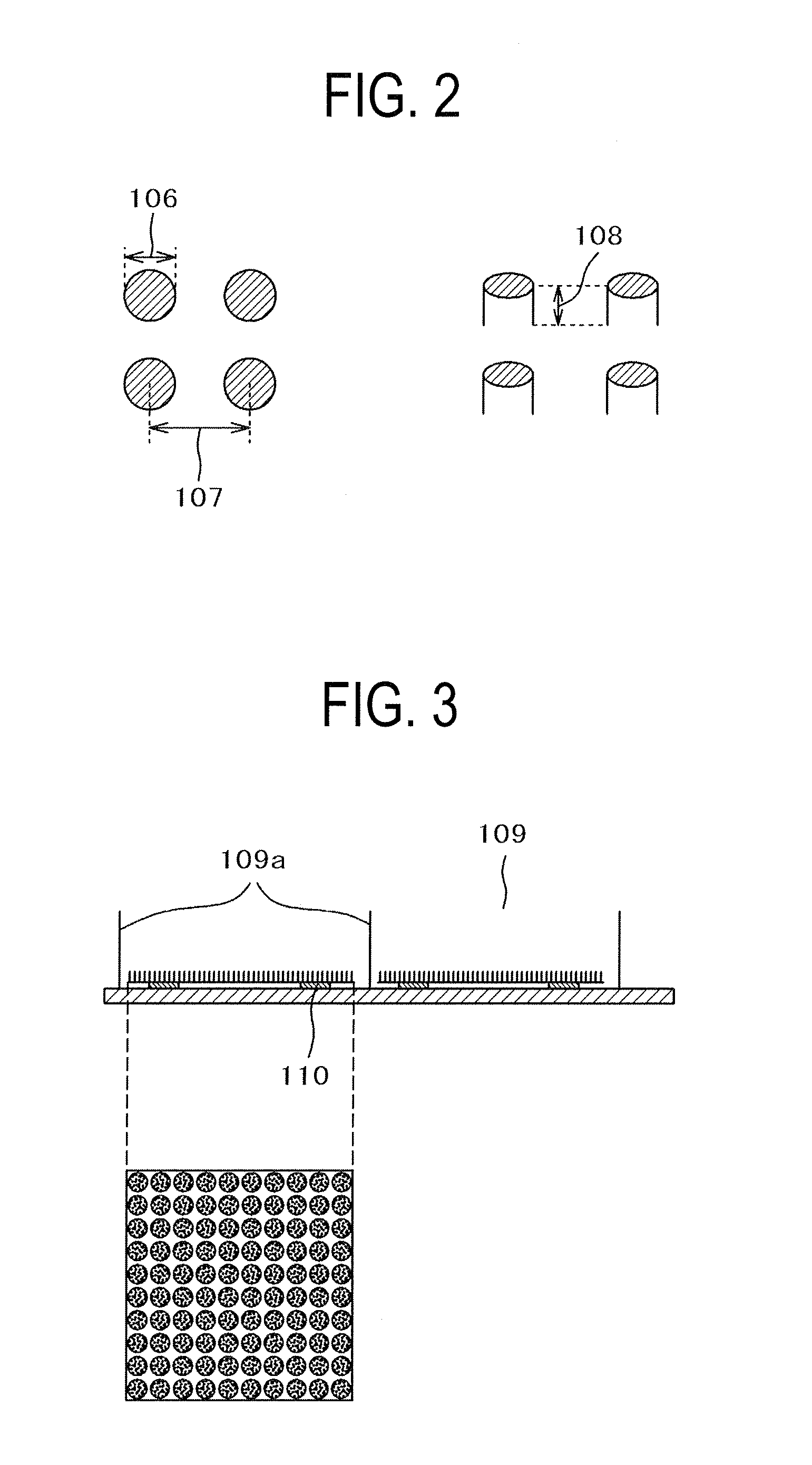Culture substrate, culture sheet, and cell culture method
- Summary
- Abstract
- Description
- Claims
- Application Information
AI Technical Summary
Benefits of technology
Problems solved by technology
Method used
Image
Examples
example 1
[0052]In Example 1, a case in which the culture sheet is applied to a chamber slide being a culture sheet holding member is shown. Hereinafter, unlike conventional nanopillar sheets, a sheet in the present invention that has a partition structure forming the culture region, and in the partition structure a plurality of protrusions are formed, is referred to as a culture sheet. The culture sheet is made with materials without bad effects on cells, in this example, polystyrene is used. However, needless to say, the material is not limited to polystyrene.
[0053]FIG. 1 is a diagram of a scanning electro microscope photograph of the culture sheet 100 made in Example 1. Also at the same time, FIG. 1 shows a structure of the holes 101 constituted by partition structures 102 (hereinafter referred to as hole) a plurality of which existing per a culture sheet. Inside of the holes 101 constitutes a culture region being a cell tissue forming unit.
[0054]A plurality of protrusions 102 held on the ...
example 2
[0072]Next, according to FIG. 4 and FIG. 5, the second example is explained. In Example 2, the constitution of a multi-well plate with a culture sheet, and its manufacturing example are shown. FIG. 4(a) is the bottom view of the frame 111 constituting a multi-well plate. In the frame 111 being the holding material of the culture sheet, in the surface space of about 125 mm wide and about 80 mm long and about 20 mm high, four holes in a vertical row and 6 holes in a horizontal row, totally 24 cylindrical holes 111a are molded. As the material, polystyrene is used.
[0073]The number of holes formed in the frame is normally from 6 to 1536. Since the number is changed depending on the application, also in the case of this frame, the number of holes is not limited to 24. In addition, the material of the frame is not limited to polystyrene.
[0074]In manufacturing of the culture substrate, the frame 111 and a culture sheet 100 are jointed with ultrasound deposition.
[0075]The frame is prelimina...
example 3
[0100]In Example 3, an applying example of cells to tissue cells with using the culture substrates manufactured in Example 1 and Example 2 is shown. In development of new drugs, construction of a three-dimensional tissue which reflects vital functions has demands from various evaluations using cells as alternatives to animal experiments.
[0101]In addition, since three-dimensional tissues must be formed before culturing induced pluripotent stem cells (iPS cells) and embryonic stem cells (ES cells) and differentiating to object cells, also in regenerative medicine, a technology which easily constructs three-dimensional tissues has been demanded. Against such backdrop, an example to form three-dimensional tissues by especially using chamber slides is shown here. However, even if multi-well plates are used, essential parts of cell culturing are the same. In the present example, a case using rat liver cells is shown, but as described above, the present invention is applicable to various a...
PUM
 Login to View More
Login to View More Abstract
Description
Claims
Application Information
 Login to View More
Login to View More - R&D
- Intellectual Property
- Life Sciences
- Materials
- Tech Scout
- Unparalleled Data Quality
- Higher Quality Content
- 60% Fewer Hallucinations
Browse by: Latest US Patents, China's latest patents, Technical Efficacy Thesaurus, Application Domain, Technology Topic, Popular Technical Reports.
© 2025 PatSnap. All rights reserved.Legal|Privacy policy|Modern Slavery Act Transparency Statement|Sitemap|About US| Contact US: help@patsnap.com



